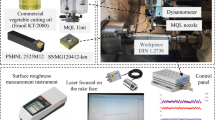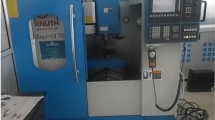Abstract
Energy consumption modeling of CNC machine tools is a prerequisite for manufacturers to save energy, reduce environmental pollution, and increase profits. It is of great significance to the healthy development of manufacturing. This paper aims to provide a power model suitable for predicting energy consumption of processing multiple materials in end milling. Firstly, this paper summarizes some limitations in the existing empirical power model of machine tool in cutting state (e.g., the applicability of predicting cutting energy consumption for various materials, the ease of obtaining power model coefficients, and the prediction accuracy of a model). Secondly, the cutting energy is analyzed from the perspective of mechanical mechanics. Combining the empirical and theoretical models analysis, key variables that affect the energy consumption in cutting status were determined. Then, an improved cutting state power model is proposed. The proposed power model is suitable for processing multiple materials in end milling. Thirdly, through experimental research, the effect of key variables on cutting power is discussed, especially its influence on the elastic-plastic term, velocity term, and thermal softening term in the calculation of equivalent shear stress. Suggestions for selecting different empirical power models are also discussed. Finally, the proposed model was verified, and the energy consumption of the end milling process was predicted. The proposed model improved applicability, accuracy, and rapidity to a certain extent of existing empirical models.





Similar content being viewed by others
Data availability
The data that support the findings of this study are available from the corresponding author upon reasonable request.
References
Duflou JR, Sutherland JW, Dornfeld D, Herrmann C, Jeswiet J, Kara S, Hauschild M, Kellens K (2012) Towards energy and resource efficient manufacturing: A processes and systems approach[J]. CIRP Ann Manuf Technol 61(2):587–609
Tang Y, Yang Q, Li C, Xiao Q, Chen X (2019) Process Route Optimization for Generalized Energy Efficiency and Production Time in Machining System. 2019 IEEE International Conference on Service Operations and Logistics, and Informatics (SOLI), Zhengzhou, China, pp 110–115. https://doi.org/10.1109/SOLI48380.2019.8955046.
Cai W, Liu F, Xie J, Zhou XN (2017) An energy management approach for the mechanical manufacturing industry through developing a multi-objective energy benchmark. Energy Convers Manag 132:361–371
Liu P, Tuo J, Liu F, Li C, Zhang X (2018) A novel method for energy efficiency evaluation to support efficient machine tool selection. J Clean Prod 191:57–66
Cao H, Li H, Cheng H, Yi L, Yin R, Chen Y (2012) A carbon efficiency approach for life-cycle carbon emission characteristics of machine tools. J Clean Prod 37(4):19–28
Liu W, Li L, Cai W, Li C, Li L, Chen X, Sutherland JW (2020) Dynamic characteristics and energy consumption modelling of machine tools based on bond graph theory. Energy 212:118767
Peng T, Xu X (2014) Energy-efficient machining systems: a critical review. Int J Adv Manuf Technol 72(9-12):1389–1406
Zhou L, Li J, Li F, Meng Q, Li J, Xu X (2016) Energy consumption model and energy efficiency of machine tools: a comprehensive literature review. J Clean Prod 112(Part5):3721–3734
Gutowski TG, Branham MS, Dahmus JB, Jones AJ, Thiriez A, Sekulic DP (2009) Thermodynamic analysis of resources used in manufacturing processes. Environ Sci Technol 43(5):1584–1590
Kara S, Li W (2011) Unit process energy consumption models for material removal processes. CIRP Ann Manuf Technol 60(1):37–40
Li L, Yan J, Xing Z (2013) Energy requirements evaluation of milling machines based on thermal equilibrium and empirical modelling. J Clean Prod 52(4):113–121
Merchant ME (1945) Mechanics of the metal cutting process. II. Plasticity conditions in orthogonal cutting. J Appl Phys 16(6):318–324
Shaw MC (2005) Metal cutting principles[M]. Oxford university press, New York
Oxley P (1962) Shear angle solutions in orthogonal machining. Int J Mach Tool Des Res 2(3):219–229
Huang Y, Liang SY (2003) Cutting forces modeling considering the effect of tool thermal property—application to CBN hard turning. Int J Mach Tool Manu 43(3):307–315
Karpat Y, Özel T (2006) Predictive analytical and thermal modeling of orthogonal cutting process—part I: predictions of tool forces, stresses, and temperature distributions. J Manuf Sci Eng 128(2):435–444
Lalwani DI, Mehta NK, Jain PK (2009) Extension of Oxley's predictive machining theory for Johnson and Cook flow stress model. J Mater Process Technol 209(12):5305–5312
Shao H, Wang HL, Zhao XM (2004) A cutting power model for tool wear monitoring in milling. Int J Mach Tool Manu 44(14):1503–1509
Yoon HS, Lee JY, Kim MS, Ahn SH (2014) Empirical power-consumption model for material removal in three-axis milling. J Clean Prod 78(78):54–62
Zhong Q, Tang R, Lv J, Jia S, Jin M (2016) Evaluation on models of calculating energy consumption in metal cutting processes: a case of external turning process. Int J Adv Manuf Technol 82(9-12):2087–2099
Kline WA, Devor RE, Lindberg JR (1982) The prediction of cutting forces in end milling with application to cornering cuts. Int J Mach Tool Des Res 22(1):7–22
Diaz N, Choi S, Helu M, Chen Y, Jayanathan S , Yasui Y, Kong D, Pavanaskar S, Dornfeld D (2010) Machine tool design and operation strategies for green manufacturing. Lab Manuf Sustain
Jiang Z, Gao D, Yong L, Kong L, Shang Z (2019) Electrical energy consumption of CNC machine tools based on empirical modeling. Int J Adv Manuf Technol 100:2255–2267
Zhou L, Li J, Li F, Xu X, Wang L, Wang G, Kong L (2017) An improved cutting power model of machine tool in milling process. Int J Adv Manuf Technol 91(5-8):2383–2400
Cook NH (1966) Manufacturing analysis[M]. Addison-Wesley Publishing Company, Massachusetts, pp 36–38
Johnson GR, Cook WH (1985) Fracture characteristics of three metals subjected to various strains, strain rates, temperatures and pressures. Eng Fract Mech 21(1):31–48
Zhou L, Li F, Zhao F, Li J, Sutherland JW (2019) Characterizing the Effect of Process Variables on Energy Consumption in End Milling. Int J Adv Manuf Technol 101(9-12):2873–2848
Acknowledgment
This work is financially supported by Science and Technology Planning Project of Guizhou Province of China (No. Qian Ke He Ji Chu -ZK[2021] Yi Ban 274) and Guizhou University of Finance and Economics General Project of School-level Scientific Research Funding (NO.2019XYB10).
Funding
This work is financially supported by Science and Technology Planning Project of Guizhou Province of China (No. Qian Ke He Ji Chu -ZK[2021] Yi Ban 274) and Guizhou University of Finance and Economics General Project of School-level Scientific Research Funding (NO.2019XYB10).
Author information
Authors and Affiliations
Contributions
Lirong Zhou is responsible for the study of energy consumption models, the collection and analysis of experimental data, and the writing of papers.
Fangyi Li is responsible for the overall design of the research and article’s framework. Liming Wang is responsible for the design of experimental methods.
Yue Wang is responsible for the translation and revision of the language of the paper.
Geng Wang is responsible for the collection of experimental data.
Corresponding author
Ethics declarations
Ethical approval
Ethics approval was not required for this research.
Consent to participate
We declare that all authors agree to participate in the research and publication of this article.
Consent to publish
The publication of this research in this journal has been approved by the co-authors.
Competing interests
We declare that there are no financial and intellectual property conflicts of interest in this research.
Additional information
Publisher’s note
Springer Nature remains neutral with regard to jurisdictional claims in published maps and institutional affiliations.
Rights and permissions
About this article
Cite this article
Zhou, L., Li, F., Wang, L. et al. A new energy consumption model suitable for processing multiple materials in end milling. Int J Adv Manuf Technol 115, 2521–2531 (2021). https://doi.org/10.1007/s00170-021-07078-3
Received:
Accepted:
Published:
Issue Date:
DOI: https://doi.org/10.1007/s00170-021-07078-3




